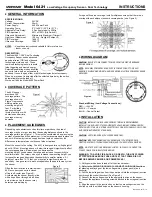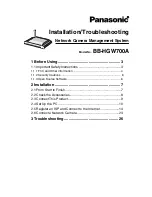
♦
GENERAL INFORMATION
SPECIFICATIONS:
Voltage:
24VDC
Current Consumption:
20mA
Power Supply:
6400 Power Pack
Operating Temp:
0°C to 55°C (32°F to 131°F )
Adjustable Time Delay:
5 Sec (test mode) to 30 Min
PIR Adjustment:
50% or 100% (Dip Switch 1)
Ultrasonic Adjustment:
Minimum to Maximum (Trimpot 1)
Light Level Adjustment:
100 Lux - Daylight (Trimpot 2)
PIR Coverage:
1600 ft
2
Ultrasonic Coverage:
1000 ft
2
NOTES:
-
Keep these instructions available for future reference.
- Indoor use only.
DESCRIPTION:
The Model 6421, 360° Dual-Technology
Occupancy Sensor unites advanced
passive infrared (PIR) and ultrasonic
technologies into one unit. These
combined technologies help to avoid
false triggering and wasted energy.
Selectable operating modes allow the
sensor to turn a load on automatically
and keep it on as long as either or both technologies detect occupancy.
When no movement is detected after the selected time delay, the switch
automatically turns the load off.
Works well with the Model 6400 Power Pack.
♦
COVERAGE PATTERN
The 6421 sensor
provides a 360°
coverage pattern. The
coverage shown in
Figure 1 represents
walking motion at a
mounting height of 9
feet. For building
spaces with lower
levels of activity or with
obstacles and barriers,
coverage size may
decrease.
♦
PLACEMENT GUIDELINES
Depending upon obstacles such as furniture or partitions, the area of
coverage may be more or less than the sensing distances shown in the
coverage pattern (see Figure 1). This must be considered when planning the
number of sensors and their placement. It is also recommended to place the
sensor 4-6 feet away from air supply ducts as rapid air currents or the
differences in temperatures could cause false activations.
Mount the sensor to the ceiling. The 6421 is designed for a ceiling height of
about 8-10 feet. Mounting above or below this range will significantly affect
the coverage patterns. Be aware as you decrease the
mounting height, you decrease the range and increase the sensitivity to
smaller motions. Conversely, when you increase the mounting height, you
increase the range and decrease the sensitivity to smaller motions. At
heights of more than 12-14 feet, you may start to significantly reduce
sensitivity. As a general rule, each occupant should be able to clearly view
the sensor.
Often the best location to install a model
6421 occupancy sensor in a closed
office is off-center (see Figure 2).
Avoid placing the sensor directly in line
with an open door through which it has
a clear view out, as the sensor may
detect people walking by.
For open office area coverage, install multiple sensors so that there is an
overlap with each adjacent sensor's coverage area. (see Figure 3)
♦
WIRING DIAGRAM
CAUTION:
BE SURE TO DISCONNECT POWER FROM THE CIRCUIT BREAKER
BEFORE WIRING!
NOTE:
EACH 6400 POWER PACK CAN SUPPLY POWER FOR UP TO SIX 6421
SENSORS. WHEN USING MORE THAN SIX SENSORS, MULTIPLE POWER PACKS ARE
REQUIRED.
Standard Wiring (Low Voltage Connections):
RED --- +24VDC
BLACK --- Common
BLUE --- Control Output
♦
INSTALLATION
CAUTION:
INSTALLATION BY A LICENSED ELECTRICIAN IS RECOMMENDED.
INSTALLATION AND USE OF THIS EQUIPMENT SHOULD BE IN ACCORDANCE WITH
PROVISIONS OF THE U.S. NATIONAL ELECTRICAL CODE, APPLICABLE LOCAL CODES,
AND PERTINENT INDUSTRY STANDARDS.
CAUTION:
USE THIS DEVICE WITH COPPER WIRE ONLY.
CAUTION:
IMPROPER WIRING CAN CAUSE DAMAGE TO THE POWER PACK,
LIGHTING SYSTEM, OCCUPANCY SENSOR(S), AND OTHER CONTROL DEVICES.
NOTE:
MOST APPLICATIONS REQUIRE UL LISTED, 18-22 AWG, 3-CONDUCTOR,
CLASS 2 CABLE FOR LOW-VOLTAGE WIRING.
WARNING: TO AVOID FIRE, SHOCK, OR DEATH, TURN OFF POWER
AT CIRCUIT BREAKER OR FUSE AND TEST THAT POWER IS OFF
BEFORE WIRING SENSORS OR POWERPACKS!
1) Verify power has been turned off at the circuit breaker.
2) Refer to the WIRING DIAGRAM & PLACEMENT GUIDELINES sections
for planning and laying out the low-voltage wiring, power pack(s), and
sensor(s).
3) Pull the low-voltage wires from the power pack into the octogonal junction
box through the conduit knockout (See Figure 5).
4) Connect the low-voltage wires to the appropriate wires on the sensor.
5) Loosen the appliance mounting screws attached to the octogonal junction
box.
6) Align the sensor in the junction box so that the mounting screws on the
box line up with the slotted holes on the sensor's housing.
Model 6421
Low-Voltage Occupancy Sensor - Dual Technology
INSTRUCTIONS
BX1266A, 02/17/14
Figure 2
Figure 1
Figure 3
Figure 4




















